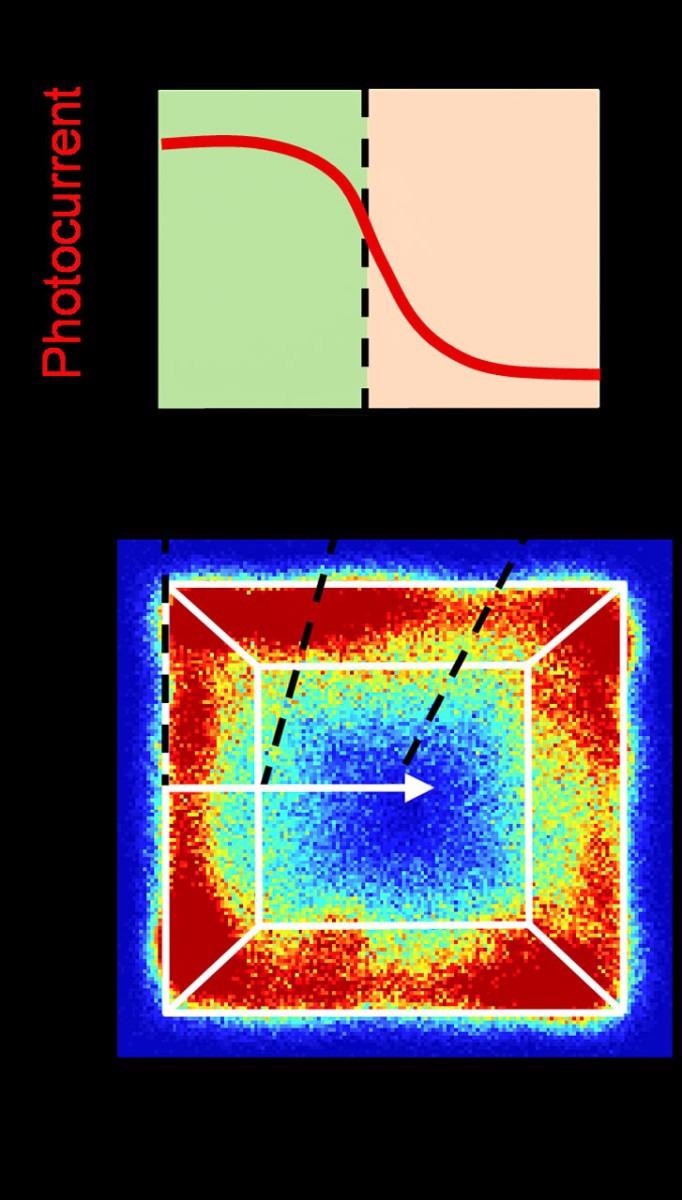Two-dimensional semiconductors have a big edge as far as creating next-generation electronics is concerned. They are quicker, stronger and highly efficient. Yet, they are extremely hard to fabricate.
 A high-resolution map of a photocatalyst particle shows the transition zones of reactivity and the corresponding spatial variation of photoelectrochemical performance across the inter-facet edge. Image Credit: Cornell University.
A high-resolution map of a photocatalyst particle shows the transition zones of reactivity and the corresponding spatial variation of photoelectrochemical performance across the inter-facet edge. Image Credit: Cornell University.
Many of the three-dimensional semiconductor particles also have an edge, thanks to their geometrically altered surfaces. Scientists from Cornell University have found that the junctures at such facet edges exhibit 2D properties, which could be leveraged for photoelectrochemical processes. Here, light has been utilized to drive chemical reactions that can promote solar energy conversion technologies.
This study, headed by Peng Chen, the Peter J.W. Debye Professor of Chemistry in the College of Arts and Sciences, could also help renewable energy technologies that decrease carbon dioxide, convert nitrogen into ammonia and generate hydrogen peroxide.
The study was published on December 24th, 2021, in the Nature Materials journal. The study lead author of the paper is postdoctoral researcher Xianwen Mao.
For their study, the scientists concentrated on the semiconductor bismuth vanadate, whose particles can absorb light and further utilize that energy to oxidize water molecules — a clean method of producing hydrogen and oxygen.
The semiconductor particles are known to be anisotropically-shaped; implying that they consist of 3D surfaces, are full of facets that are angled toward each other and meet at edges on the particle surface. But, not all facets seem to be equal. They can exhibit various structures that, eventually, lead to different electronic properties and energy levels.
Because they have different energy levels when they join at an edge, there’s a mismatch, and the mismatch gives you a transition. If you had a pure metal, it wouldn’t have this property.
Peng Chen, Peter J.W. Debye Professor, Chemistry, College of Arts and Sciences, Cornell University
With the help of a pair of high-spatial-resolution imaging methods, Mao and Chen quantified the photoelectrochemical current and surface reactions at several points over each facet and the adjoining edge in between. Further, to map the transition alterations, they used meticulous quantitative data analysis.
The scientists were thrilled to discover that the three-dimensional particles had the ability to possess the electronic properties of two-dimensional materials. Here, the transition occurs gradually over the so-called transition zone — near the edge where the facets converge. This is a discovery that had never been visualized and could not have been disclosed without high-resolution imaging.
Mao and Chen hypothesize that the transition zone’s width is comparable to the facet’s size. That would possibly give scientists an approach to “tune” the electronic properties and tailor the particles used for photocatalytic processes. Furthermore, they could tune the properties by altering the widths of the near-edge transition zones through chemical doping.
The electronic property is dependent on which two facets are converging at an edge. Now, you basically can design materials to have two desired facets merge. So there’s a design principle. You can engineer the particle for better performance, and you can also dope the material with some impurity atoms, which changes the electronic property of each facet.
Peng Chen, Peter J.W. Debye Professor, Chemistry, College of Arts and Sciences, Cornell University
Chen added, “And that will also change the transition associated with this inter-facet junction. This really points to additional opportunities for three-dimensional semiconductor particles.”
The study was financially supported by the U.S. Department of Energy’s Office of Science — Basic Energy Sciences, Catalysis Science program. The scientists used the Cornell Center for Materials Research, supported by the National Science Foundation.
Journal Reference:
Mao, X & Chen, P (2021) Inter-facet junction effects on particulate photoelectrodes. Nature Materials. doi.org/10.1038/s41563-021-01161-6.